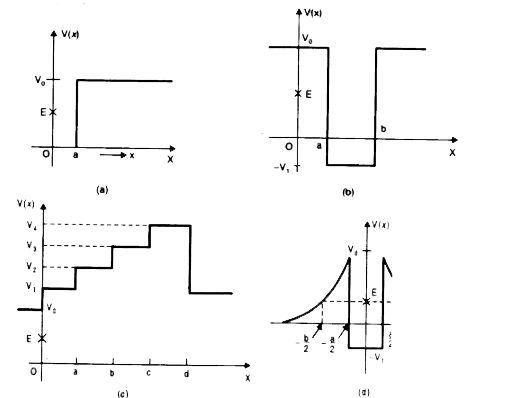Given in fig are examples of some potential energy functions in one dimension. The total enrgy of the particle is indicated by a cross on the ordinate axis. In each case, specify the regions, if any, in which the particle cannot be found for the given energy. Also, indicate the minimum total energy the particle must have in each case. Think of simple physical contexts for which these potential energy shapes are relevant.

We know that total energy E=K.E.+P.E. or K.E.=E−P.E. and K.E. can never be negative. The object cannot exist in the region, where its K.E. would becomenegative.
(i) For x>a, P.E. (V0>E
∴ K.E. becomes negative. Hence, the object connot exist in the region x>a.
(ii) For x<a and x>bP.E.(V0)>E.
∴ K.E. becomes negative. Hence the object cannot be present in the region x>a and x>b.
(iii) Object cannot exist in any region because P.E. (V0>E in every region.
(iv) On the same basis, the object cannot exist in the region−b/2<x<−a/2 and a/2<x<b/2.
Topper's Solved these Questions
- WORK, ENERGY AND POWERBOOK - PRADEEPCHAPTER - WORK, ENERGY AND POWEREXERCISE - Additional Exercises
3 Videos
- WORK, ENERGY AND POWERBOOK - PRADEEPCHAPTER - WORK, ENERGY AND POWEREXERCISE - higher order thinking skills
10 Videos
- WORK, ENERGY AND POWERBOOK - PRADEEPCHAPTER - WORK, ENERGY AND POWEREXERCISE - Advanced Problems For Competitions
20 Videos
- THERMODYNAMICSBOOK - PRADEEPCHAPTER - THERMODYNAMICSEXERCISE - Assertion- Reason Type Questions
19 Videos
Similar Questions
Given in fig are examples of some potential energy functions in one dimension. The total enrgy of the particle is indicated by a cross on the ordinate axis. In each case, specify the regions, if any, in which the particle cannot be found for the given energy. Also, indicate the minimum total energy the particle must have in each case. Think of simple physical contexts for which these potential energy shapes are relevant.

View SolutionThe total energy of a particle executing simple harmonic motion is
View Solution
Knowledge Check
In which case does the potential energy decrease ?
Aon compressing the springBon stretching a springCon moving a body against gravitational pullDon rising of an air bubble in waterThe total energy of particle executing SHM is proportional to
AdisplacementBfrequencyCvelocity at mean positionDsquare of amplitudeThe total energy of particle executing SHM is proportional to
AdisplacementBfrequencyCvelocity at mean positionDsquare of amplitude
A particle of mass m is executing SHM about its mean position. The total energy of the particle at given instant is
View SolutionThe total energy of particle performing SHM depend on : -
View SolutionA particle of mass m executing S.H.M. about its mean position. The total energy of the particle at given instant is
View SolutionThe kinetic energy of the particles is maximum in the case of ____.
View SolutionPotential energy of the particle performing S.H.M. is
View Solution
